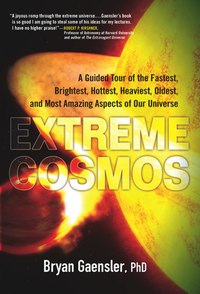Review: Extreme Cosmosby Jeff Foust
|
| Gaensler goes beyond simply identifying the biggest and smallest, or hottest and coldest, objects, explaining why and how they’ve reached those extremes and what they mean for our broader understanding of the universe. |
What’s more, continuing discoveries further expand those astronomical scales, as researchers discover ever more distant, larger, or otherwise more extreme objects. These discoveries make good fodder for news articles, but these reports often don’t delve beyond the superlative itself: for example, every several months there is news of a new most-distant object discovered, with a fractionally higher redshift, but often without putting that discovery into context for what that means about our understanding about the origins and early development of the universe.
In Extreme Cosmos, Australian astronomer Bryan Gaensler does provide the big picture about those extremes of the universe. At first glance, the book appears to be superficial, organized into chapters that look at various extremes, from mass and time to temperature and electromagnetism. In those chapters, though, he goes beyond simply identifying the biggest and smallest, or hottest and coldest, objects, explaining why and how they’ve reached those extremes and what they mean for our broader understanding of the universe.
Gaensler writes in a conversational tone, drawing upon his own experiences to help illustrate and add color to these discussions. (One quibble: in the section on density, he uses the units of ounces per cubic centimeter, an odd mashup of imperial and metric units; the rest of the book generally uses imperial units.) Interestingly, the book doesn’t include any photos or other illustrations, an odd omission given the highly visual nature of astronomy and the ability of images and diagrams to communicate relative sizes and scales. Despite this lack of illustration, Extreme Cosmos is still a fine guide to the range of physical characteristics of objects in the universe—and, more importantly, explaining their relevance.
